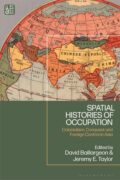Étiquette : David Serfass
-

Mapping China under Japanese Occupation: Spatial Configurations of State Power during Wartime, 1937–45
Baillargeon, D., & Taylor, J.E. (Eds.). (2022). Spatial Histories of Occupation: Colonialism, Conquest and Foreign Control in Asia. London: BloomSerfass, D. (2022). Mapping China under Japanese Occupation: Spatial Configurations of State Power during Wartime, 1937–45. In D. Baillargeon & J.E. Taylor (Eds.). Spatial Histories of Occupation: Colonialism, Conquest and Foreign Control in Asia (pp. 119–142). London: Bloomsbury Academic.…
-
State Building through Political Disunity in Republican China
Numéro spécial de la revue Twentieth-Century China (vol. 47, n°1, janv. 2022), co-édité par Xavier Paulès et David Serfass, intitulé “State Building through Political Disunity in Republican China”Table des matières : http://hstcconline.org/twentieth-century-china/ → Le numéro en ligne Table of Contents Editorial by MARGHERITA ZANASI Special Issue: State Building through Political Disunity in Republican ChinaXavier Paulès and David Serfass, Guest…
-
Questioning the Teleology of the Central State in Republican China
Xavier Paulès, David Serfass, “Questioning the Teleology of the Central State in Republican China”, Twentieth-Century China, vol. 47, n°1, janv. 2022, p. 3-10.https://muse.jhu.edu/article/842938 → L’article en ligne No doubt the expansion of the reach of the state can be considered one of the prominent features of the twentieth century. Many studies have described this process in Western…
-
Redevenir des héros
David Serfass, « Redevenir des héros », Le Point, 16 décembre 2021 (chapô : “Pour mieux légitimer sa place de superpuissance dont elle estime avoir été spoliée en 1945, la Chine réinterprète sa guerre de quatorze ans contre le Japon. Une révision à double tranchant qui implique Taïwan.”). → L’article en ligne (réservé aux abonnés) “Pour mieux légitimer sa…
-
Histoires de Tintin #3 : Le Lotus Bleu, avec David Serfass
Le 29 mai 2020, David Serfass, maître de conférence, était l’invité du podcast Paroles d’histoire, pour évoquer le cinquième album des Aventures de Tintin : Le Lotus Bleu → suivez ce lien pour écouter son intervention
-
La Chine, du traité de Nankin à la proclamation de la République populaire (1842-1949)
Conférence organisée à l’Inalco le 1er février 2020 par l’Institut français de recherche sur l’Asie de l’Est, dans le cadre de la préparation du programme d’histoire du concours de la Banque d’épreuves littéraires (BEL).
-
La République de Chine : Histoire générale de la Chine (1912-1949)
Conférence enregistrée à l’Inalco le jeudi 21 novembre 2019 à l’occasion de la parution de l’ouvrage “La République de Chine : Histoire générale de la Chine” (Éditions Les Belles Lettres) : https://www.lesbelleslettres.com/livr…